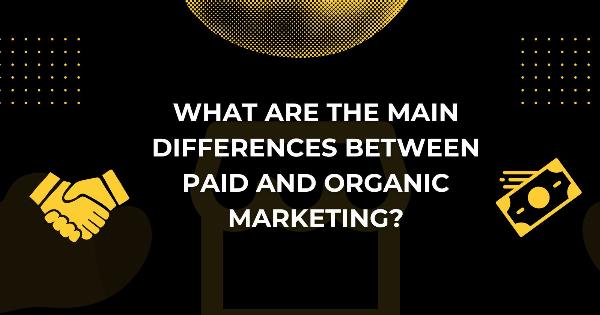What Are the Main Differences Between Paid and Organic Marketing?

Strong 8k brings an ultra-HD IPTV experience to your living room and your pocket.
In the ever-evolving digital landscape, businesses often turn to two primary strategies to increase their online visibility and drive traffic: paid marketing and organic marketing. While both methods aim to promote products or services, they operate under different principles and have distinct advantages and challenges. This article explores the main differences between paid and organic marketing, helping you decide which approach may be best for your business.
1. Definition
Paid Marketing: Paid marketing refers to any strategy where businesses pay for advertising placements to promote their offerings. This includes methods such as pay-per-click (PPC) ads, social media ads, display ads, and sponsored content.
Organic Marketing: Organic marketing encompasses methods that generate traffic and engagement without direct payment for visibility. This includes search engine optimization (SEO), content marketing, social media engagement, and unpaid promotions.
2. Cost Structure
Paid Marketing: As the name suggests, paid marketing requires a financial investment. Businesses can set budgets for campaigns based on their objectives, with costs varying based on factors such as the platform, keyword competitiveness, and audience targeting. Payment models often include cost-per-click (CPC), cost-per-impression (CPM), or flat rates for ad placements.
Organic Marketing: Organic marketing primarily involves time and effort rather than direct financial expenditure. While there may be costs associated with content creation and SEO tools, the traffic generated through organic methods is essentially “free” because businesses don’t pay for the visibility.
3. Speed of Results
Paid Marketing: Paid marketing can yield immediate results. Once an ad campaign is launched, it can quickly generate traffic and leads, allowing businesses to see a rapid return on investment. This is especially beneficial for time-sensitive promotions or new product launches.
Organic Marketing: Organic marketing takes time to build momentum. Achieving high rankings in search engines or establishing a robust social media presence can take months or even years. While the results may not be as quick, they are generally more sustainable over the long term.
4. Longevity and Sustainability
Paid Marketing: The effects of paid marketing last only as long as the budget allows. Once the ad spend stops, visibility and traffic typically decrease rapidly. Businesses must continually invest in paid campaigns to maintain their presence.
Organic Marketing: Organic efforts, particularly those related to SEO, can have lasting effects. Quality content that ranks well can continue to drive traffic for months or years without further investment. Once established, organic channels can provide a steady flow of traffic and leads.
5. Trust and Credibility
Paid Marketing: While paid ads can effectively promote a product, they may not always convey the same level of trust and credibility as organic content. Many users tend to skip over ads or view them as less authentic.
Organic Marketing: Organic content, such as informative articles, engaging social media posts, and user-generated content, often builds trust and credibility with audiences. Customers are more likely to engage with and share content that they perceive as genuine and valuable.
6. Audience Targeting
Paid Marketing: Paid advertising offers advanced targeting options, allowing businesses to reach specific demographics, locations, and interests. This precision can lead to higher conversion rates as ads are shown to users more likely to be interested in the product or service.
Organic Marketing: While organic strategies can also reach targeted audiences, they typically rely on creating valuable content that attracts users based on their search intent or interests. This approach may not be as precise as paid targeting but can still effectively reach the right audience over time.
7. Analytics and Control
Paid Marketing: Paid campaigns usually provide detailed analytics and metrics, allowing businesses to track performance, ROI, and user behavior in real time. This data enables marketers to make immediate adjustments to optimize campaigns.
Organic Marketing: Although organic efforts can be tracked using various analytics tools, the metrics may not provide the same level of granularity as paid campaigns. Understanding organic traffic may take longer to analyze, but tools like Google Analytics can still offer valuable insights.
Conclusion
Understanding the differences between paid and organic marketing is essential for developing a successful digital marketing strategy. Both methods offer unique advantages and challenges, and leveraging the strengths of each can help businesses achieve greater visibility and engagement. If you’re looking to enhance your marketing skills and strategies, consider enrolling in digital marketing training in Ghaziabad, Lucknow , Jodhpur and all over India.. Such programs can provide valuable insights and techniques to navigate the complexities of both paid and organic marketing effectively, helping you achieve your business goals.
FAQs about Paid vs. Organic Marketing
Q1: Which strategy is better for my business, paid or organic marketing?
A1: The best approach depends on your goals, budget, and timeline. Paid marketing is ideal for quick results and precise targeting, while organic marketing is beneficial for long-term sustainability and credibility. Many businesses find success using a combination of both strategies.
Q2: How much should I invest in paid marketing?
A2: Investment in paid marketing can vary widely based on your industry, competition, and goals. Start by setting a budget that aligns with your overall marketing strategy and gradually increase it based on the performance of your campaigns.
Q3: Is it possible to rely solely on organic marketing?
A3: While you can build a successful business using only organic marketing, it typically takes longer to see significant results. Combining organic strategies with paid efforts can enhance visibility and accelerate growth.
Q4: How long does it take to see results from organic marketing?
A4: Organic marketing results can vary, but it often takes several months to see significant improvements in search rankings, traffic, and engagement. Consistency in content creation and SEO efforts is key to achieving long-term results.
Q5: How do I measure the success of my paid and organic campaigns?
A5: Use analytics tools to track key performance indicators (KPIs) for both paid and organic campaigns. For paid marketing, focus on metrics like click-through rates (CTR), conversion rates, and ROI. For organic marketing, monitor traffic sources, user engagement, and conversion rates from organic channels.
Note: IndiBlogHub features both user-submitted and editorial content. We do not verify third-party contributions. Read our Disclaimer and Privacy Policyfor details.


